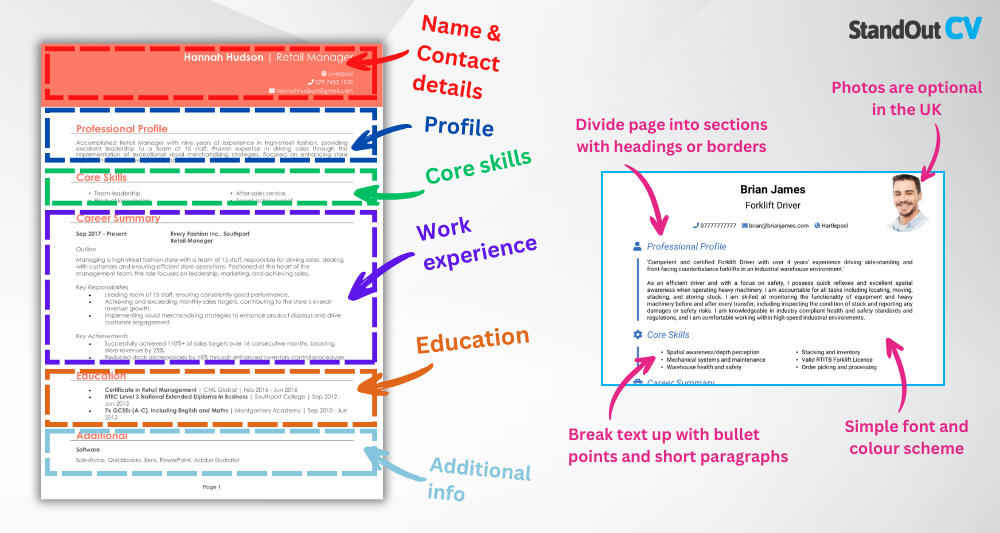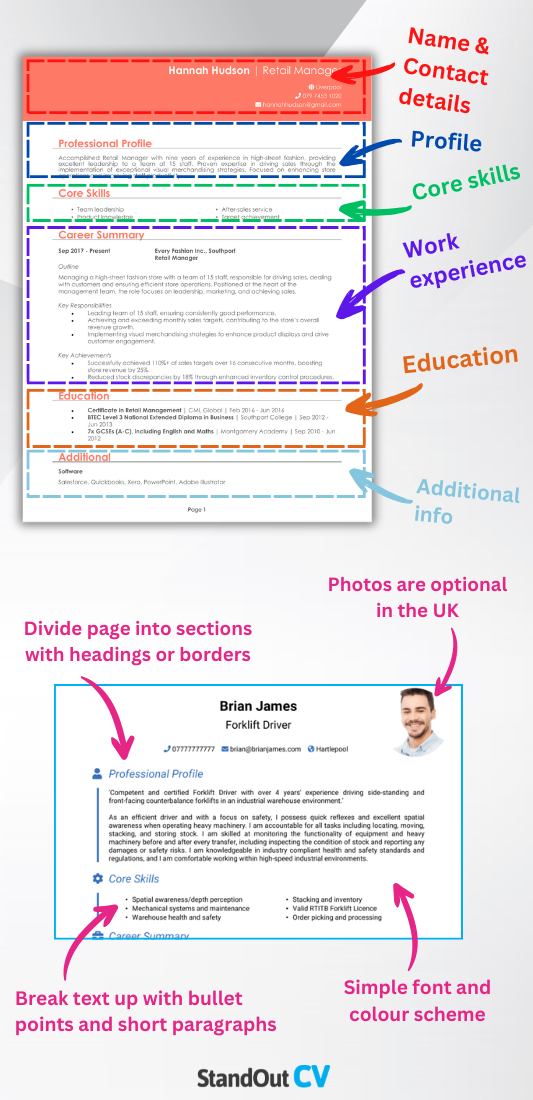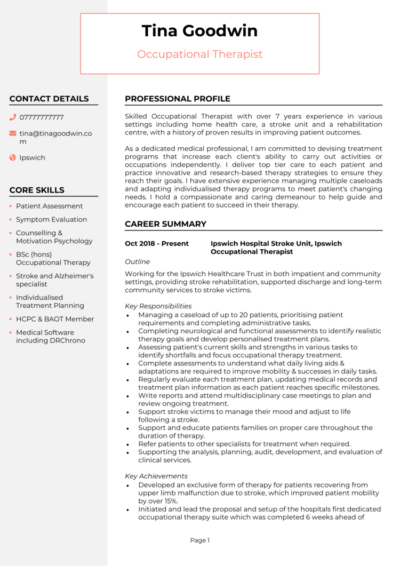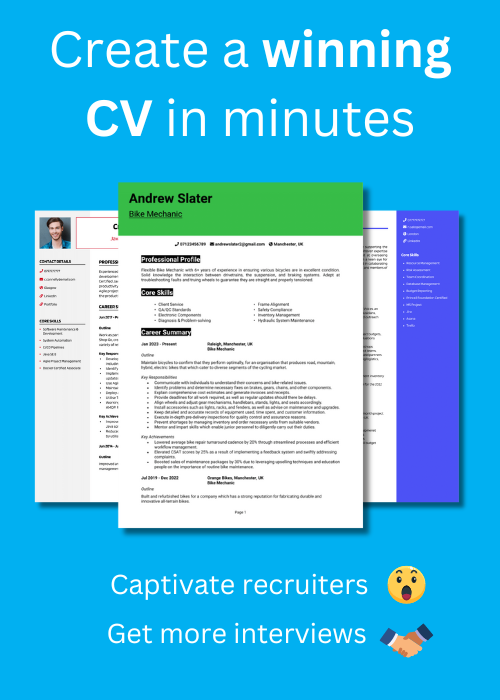In healthcare, the smallest details matter – and that includes your CV. If it’s unclear or too vague, you could be passed over, even with the right qualifications and patient outcomes to back you up.
This guide, complete with 3 Occupational Therapist CV examples, will help you put together a focused, professional CV that highlights your impact – so you can secure more interviews and move forward in your OT career.
Occupational Therapist CV

OT Assistant CV

Occupational Therapy Student CV

How to write your Occupational Therapist CV
Discover how to craft a winning Occupational Therapist CV that lands interviews with this simple step-by-step guide.
This guide takes you step by step through writing a CV. You’ll learn how to organise your qualifications and describe your clinical experience and specialisms clearly and effectively.
It’s a competitive and rewarding role, but following these steps will prepare you for your next move – and show exactly how you improve lives through meaningful, person-centred care.
How should you structure and format an Occupational Therapist CV?


As an Occupational Therapist, structure isn’t just helpful – it’s essential. Whether you’re developing a care plan or delivering interventions, the process depends on clarity and purpose. Your CV structure should reflect that same professional approach. A recruiter should be able to glance at it and immediately understand where you’ve worked and who you’ve supported, as well as the impact you’ve made.
Here’s the layout to follow:
- Name and contact details – Place your name and personal details prominently at the top of your CV for quick access. Adding a photo is up to you.
- Profile – Open with a compelling overview of your skills, experience, and career goals.
- Core skills – List your key abilities in this section, focusing on those that will be most relevant to the job.
- Work experience – Walk through your employment history in reverse chronological order, focusing on your responsibilities and achievements.
- Education – List the qualifications and certificates that make you the right fit.
- Additional info – You can optionally list any relevant hobbies and interests which help to convey that you’re the right fit for the role.
Format your CV the same way you’d organise a client file: keep sections clearly labelled, use bullet points to highlight practical detail, and stick to a clean, legible font. Limit the document to two pages in length, and make sure every element earns its place – from your opening profile to your final qualification. A CV format that’s clear and outcome-focused is your first chance to demonstrate the same values you bring to your practice.
Writing an Occupational Therapist CV profile


Think of this paragraph as your verbal “first impression” – a chance to introduce yourself as a confident, capable OT with a client-centred mindset and measurable impact.
Whether you’re restoring independence after injury or helping patients adjust to life-altering conditions, your work changes lives – and your CV profile should reflect that. It’s not about listing buzzwords; it’s about showing how your clinical knowledge and compassion translate into real-world results.
Occupational Therapist CV profile examples
Profile 1
Experienced Occupational Therapist with over 10 years of experience supporting adults in NHS community rehab and acute hospital settings. Skilled in delivering person-centred care plans, conducting functional assessments, and supporting patients with neurological, orthopaedic, and long-term conditions. Known for collaborative working and a holistic approach to recovery and independence.
Profile 2
Compassionate Occupational Therapist with six years of experience in paediatric and educational settings, supporting children with developmental delays, ASD, and sensory processing disorders. Proficient in conducting EHCP assessments, working with multi-agency teams, and designing tailored interventions that support school inclusion and home independence.
Profile 3
Motivated Occupational Therapist with five years of experience in mental health services, providing structured intervention for individuals with complex emotional, cognitive, and behavioural needs. Confident managing caseloads, delivering recovery-focused treatment plans, and facilitating daily living skills through therapeutic engagement.
Details to put in your Occupational Therapist CV profile
Here’s what to put in your CV profile:
- Where you worked – NHS Trusts, private practices, social services, schools, mental health services, or rehab centres
- Your top qualifications – BSc/MSc in Occupational Therapy, HCPC registration, and specialist CPD
- Essential skills – Functional assessments, rehabilitation planning, ADL support, mental health OT, equipment provision
- Client groups – Older adults, children, neurological, post-surgical, or mental health service users
- Approach and impact – Mention client-centred practice, holistic care, or multidisciplinary teamwork
Writing an effective core skills section


This section provides a clear and concise overview of your key clinical and interpersonal strengths. Include 4–8 bullet points tailored to the specific role – whether it’s community OT, mental health, or paediatric settings.
Make sure these CV skills are aligned with the job advert and focused on hands-on skills – avoid the mistake of listing off generic traits which recruiters overlook.
The top skills to highlight in your Occupational Therapist CV
- Functional Assessment and Evaluation – Assessing patients’ physical, cognitive, and emotional abilities to determine appropriate interventions.
- Personalised Treatment Planning – Developing tailored therapy plans to help individuals regain or improve daily living and work-related skills.
- Rehabilitation and Recovery Support – Assisting clients recovering from illness, injury, or surgery to regain independence and confidence.
- Assistive Equipment Recommendation – Identifying and recommending adaptive tools such as mobility aids, ergonomic devices, or home modifications.
- Mental Health and Wellbeing Support – Addressing psychological barriers to daily function and promoting strategies for stress and anxiety management.
- Therapeutic Activity Implementation – Guiding clients through exercises and tasks that build strength, coordination, and practical skills.
- Client and Family Education – Teaching patients and their caregivers how to manage conditions and use equipment or strategies effectively.
- Multidisciplinary Team Collaboration – Working alongside physiotherapists, doctors, nurses, and social workers to ensure cohesive patient care.
- Record Keeping and Progress Monitoring – Maintaining detailed clinical notes, treatment records, and outcome reports.
- Community and Workplace Integration – Supporting clients in returning to community life or employment through tailored occupational strategies.
Showcasing your work experience


Here’s where you showcase your practical experience as an OT. Whether you’re working in acute hospitals or specialist services, your work experience section should show how you assess, plan, and deliver effective therapy.
List your roles in reverse chronological order. For each job, use bullet points to outline your responsibilities and achievements – focus on how you supported clients and contributed to their outcomes.
And if you’re newly qualified or recently graduated, include your placements and highlight what you learned and the patient groups you worked with.
Writing job descriptions for past roles

- Outline – Provide context by naming the employer, type of setting, and the client group or caseload you supported – for example, community OT supporting older adults post-discharge.
- Responsibilities – Use action words like “assessed” and “coordinated.” For example: “assessed functional ability and developed tailored rehabilitation plans” or “coordinated equipment provision to support discharge planning.” Mention any specific tools, pathways, or frameworks you followed.
- Achievements – Demonstrate the impact of your work: reduced hospital readmissions, improved independence, positive patient feedback, or time-to-discharge improvements. Here’s a tip: use numbers and data to make outcomes feel more tangible.
How to present past roles for Occupational Therapists
Occupational Therapist | Thamesview NHS Trust
Outline
Delivered occupational therapy services for an acute hospital ward within a large NHS trust, supporting patient discharge and rehabilitation planning for adults with a range of health needs.
Responsibilities
- Conducted functional assessments for mobility, cognition, and daily living tasks
- Developed discharge plans in coordination with physiotherapists, nurses, and social workers
- Recommended equipment and home adaptations to support independent living
- Documented care plans and progress notes on electronic patient record systems
- Provided carer training and post-discharge follow-up where necessary
Achievements
- Supported 95% of patients in achieving discharge goals within planned timeframes
- Reduced delayed discharges by 18% through early intervention and care coordination
- Recognised by ward manager for consistent documentation and collaborative input
Occupational Therapist | Wilowfield Children’s Centre
Outline
Provided occupational therapy intervention for children aged 4–11 within a multi-disciplinary educational support service in collaboration with SENCOs and family teams.
Responsibilities
- Assessed fine and gross motor skills, sensory integration, and classroom participation
- Developed individualised programmes targeting handwriting, coordination, and attention
- Wrote reports for EHCP applications and attended annual review meetings
- Delivered parent workshops on sensory needs and strategies for daily routines
- Worked alongside speech therapists and educational psychologists on joint goals
Achievements
- Helped reduce classroom exclusions through targeted sensory regulation strategies
- Increased parent engagement in home programmes by 40% within a school term
- Played a key role in achieving ‘Outstanding’ SEND provision rating by Ofsted
Occupational Therapist | Bridgestone Community Mental Health
Outline
Supported adult service users within a community mental health team, developing recovery-based occupational interventions for individuals with depression, psychosis, and anxiety disorders.
Responsibilities
- Completed occupational assessments using MOHO and other standardised tools
- Ran life skills groups focused on budgeting, meal prep, and routine management
- Supported vocational goals through graded exposure and community access
- Maintained up-to-date care plans and risk assessments in line with trust policy
- Liaised with psychiatrists, social workers, and family members as part of CPA reviews
Achievements
- Increased client participation in community activities by 35% through structured planning
- Helped three long-term clients return to part-time employment within six months
- Recognised for building strong therapeutic relationships and effective goal setting
Highlighting your education


This section lists your academic and professional qualifications. Your HCPC-recognised OT degree will be the core entry, but also include postgraduate study, short courses, and CPD relevant to the role.
If you’re early in your career, include key modules or placement highlights to provide extra context. List all your education and qualifications in reverse chronological order.
The best qualifications to boost an Occupational Therapist CV
- BSc (Hons) or MSc in Occupational Therapy – The core qualification needed to practise as an OT in the UK, accredited by the HCPC.
- HCPC Registration (Health and Care Professions Council) – A legal requirement to work as an OT in the UK.
- Sensory Integration Training (SIPT or similar) – A valuable specialism for working in paediatric or neurodevelopmental roles.
- Manual Handling and Risk Assessment Training – Essential for safely supporting physical rehab and mobility-related cases.
- Postgraduate Certificate in Neurological Rehabilitation or Mental Health Practice – Demonstrates specialist expertise in a particular clinical area.





